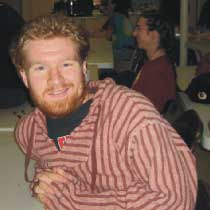I'll try to explain Making some other day. Making an explication of Making is a big project.
I Made a new pendant for my collection today. Nothing terribly fancy but I solved a major problem in design in a way I'm quite pleased with. I've had this bead for some time now. It's a robin's egg blue cracked turquoise stone about the size of the end of my thumb and very vaguely heart shaped with the hold drilled from the inside of the dimple to the point-ish area. It's a beautiful piece of turquoise.
Out of respect for the beauty and tradition of presenting turquoise and sliver together I decided that I wanted to place a sliver strand along both flat-ish sides of the stone. Well, I haven't got any appropriately gauged silver wire, but I do have some tarnish resistant silver looking wire, probably a nickel alloy, that would work. My silver wire is 24 gauge and I haven't got much of it. I was worried that it would get drowned against the turquoise. The 20 gauge silver looking wire was right, especially because I have plenty, but more than one strand would be a too dominant visual.
The challenge was to get a single strand of wire up both sides of the bead and terminate in an appropriate loop at the top. I immediately recognized that threading the hole in the bead in a traditional manner would be a bad idea as I would then have to hide one end of the wire at the bottom of the bead and construct a loop at the top with a single strand. Instead I cut a maybe five inch strand of wire and began experimenting.
The first problem was to fasten the wire in such a way that I would place the strands where I wanted them. I was attracted to the idea of incorporating the hole drilled in the stone into my design. Intuitively, I bent both ends of the wire about 1/4 inch up from the end at 90 degree angles. The angled portions I inserted into the bottom, dimpled, side of the stone. Thankfully both strands fit. I then had a loop that passed from the bottom hole around the top of the stone and back into that same hole.
I opted to twist the wire together from the top of the stone toward the top of my loop to tighten the loop. As I was twisting it I decided to try to form my (oh dear god jargon fail) I decided to try to form the loop where the (epic jargon fail) where the necklace itself would pass through and the finished pendant hang from out of the wire I was now twisting together. Unfortunately, the two strands twisted together proved disproportionately challenging to manage and mangled the single strands along the side of the turquoise as I tried to wrangle the twisted strand into place. Three failed attempts ensued.
At this point I had started using tools, specifically the round handle of a metal dentist's scraping tool, to assist in properly twisting the wire together (10 to one odds says I've now lost both my readers to "¡¡WTF!!") especially at the tricky finish at the end made trickier because it's a closed loop. I had realized that I had to do something new. Somehow I alight upon the idea of using the left over looped tail of the larger initial loop as the interface loop for the pendant and necklace. This would require a smaller initial piece of wire which I eyeballed and went to town on.
Astoundingly, this worked on the first try. Or, at least, it was the right length on the first try. Unfortunately, the handle of the dentist's tool is too fat (approximate 3/8 inch diameter) to make an attractive interface loop. My fingers don't have the precision necessary a that scale for that task and I needed a new tool. In the single-mindedness that always accompanies Making I grabbed a finished wood file with a metal shaft. The file itself is rarely useful (acquired before I understood wood working at all), but I keep the set just in case. In this case the approximate 1/8 inch diameter shaft was perfect and with only three and a half full twists my pendant was complete.
Leaving me with the simple problem of how to get the beautiful pendant, and specifically the interface loop, off of the shaft of the tool I'd used. The file portion was too large and I didn't want to cut away the rubber grip. Thankfully I was able to, after some very ... determined persuasion coax the grip off and slide my pendant unharmed to freedom. The grip even went back on!
I'm pleased as punch with the pendant which is simple and beautiful with the small coil that holds the wire tight centered on the top of the hold drilled in the turquoise stone. If I had a camera I'd share with both of you.
¡¡¡Oh dear Gods above I need jargon help with jewelry!!!
Edit: Thanks to Elethia – what I called the "interface loop" should actually be called a "bail." Good to know!

You're officially borrowing my digital camera (which I use maybe twice a year) until further noticed.
ReplyDeleteYour voice is awesome and you have important things to say. I'm glad you're here. :)
Looking forward to hear more about your ideas about "making.' Mostly I make things out of words.
ReplyDelete-identityTBD